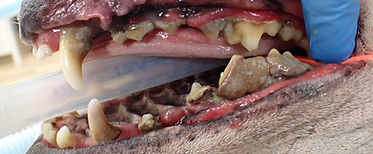
Veterinary Dental Services
Below you will find descriptions for our most common dental procedures.
Each case that is referred to us is unique and requires a specific treatment plan. The dental concerns and treatment options are discussed at length at the time of consultation. The work that is recommended may include some of the treatment options below. Please be aware that this list is not meant to be comprehensive, but is a sample of the dental care we are able to provide to our clientele.

Endodontics
Endodontics is concerned with the vitality of the pulp, or "nerve," of the tooth. If a tooth is fractured or discoloured, the pulp is often affected and may cause significant pain to your pet. All fractured teeth should be assessed regardless of whether the pulp is obviously exposed or not, as the anatomy of the tooth is such that bacteria can enter the tooth structure even if the pulp isn't directly exposed. Root canal therapy is the process of removing the pulp contents and sterilizing the pulp cavity, filling the tooth with a rubber-like compound, and sealing the tooth with restorative material. The tooth is no longer vital, but it is functional and pain-free for your pet.
_JPG.jpg)
Periodontics
Periodontal disease is the most common disease affecting our pets - a majority of dogs and cats suffer from some degree of periodontal disease. Periodontics is related to the tissues that support the teeth. When bacteria adhere to the teeth, they form a biofilm, which then calcifies and becomes calculus. These bacteria are extremely irritating to the gum tissue and start the disease process by causing gingivitis. If the disease progresses, the gingiva recedes, and the bone surrounding the teeth is lost. Periodontal pockets may occur allowing bacteria to move more deeply along the root of the tooth. Eventually, the teeth become loose and require extraction.
If addressed early enough, there are steps that can be taken to reverse or halt the progression of periodontal disease. After successful periodontal treatment, which may include extraction, patients with periodontal disease often have improved quality of life with increased energy and playfulness.

Orthodontics
Orthodontic treatment is done to treat painful malocclusions in dogs and cats. If either the top jaw (maxilla) or bottom jaw (mandible) are shorter than the other, the teeth will not line up as they are meant to. In some cases, even if the jaws are normal lengths, the teeth will still erupt in the wrong position. Malocclusions can result in an abnormal tooth to tooth contact and/or abnormal tooth to soft tissue contact. This causes pain whenever the mouth is closed.
Orthodontic treatments may include crown height reduction, movement of the misaligned teeth using an orthodontic appliance, or selective extraction.

Prosthodontics
Prosthodontic treatment involves placing metal crowns on teeth to prevent further damage and loss of structure to a tooth. Crowns are commonly placed on police or other working dogs and on dogs that are particularly hard on their teeth. Crowns can be placed to protect and provide extra strength to a vital tooth, or to a tooth treated with root canal therapy to prevent further fracture. Not all dogs require crowns after a root canal treatment.

Anesthesia
Anesthesia is fundamental to what we do at AVD and we take great pride in our culture of safety, evidence-based practice, and high standards of care. Our anesthesia service is lead by Dr. Jessica Pang and we are one of the few clinics in Alberta to have a veterinary anesthetist on staff. Our hospital environment, advanced anesthesia equipment, and staff expertise allows us to provide intensive management for every patient. Our anesthesia service takes a structured approach including individually tailored sedation and anesthetic plans, special accommodations for hospital-related anxiety and physical challenges, comprehensive perioperative monitoring, and anesthetic safety checklists. All of our patients have a dedicated team member that oversees their pre-anesthetic preparation, monitoring, and recovery while Dr. Pang provides diverse support for both routine and advanced cases. We value the trust that is placed in us, and we encourage questions and communication throughout your pet’s care pathway.
